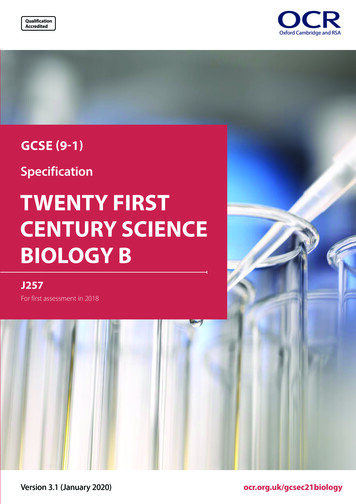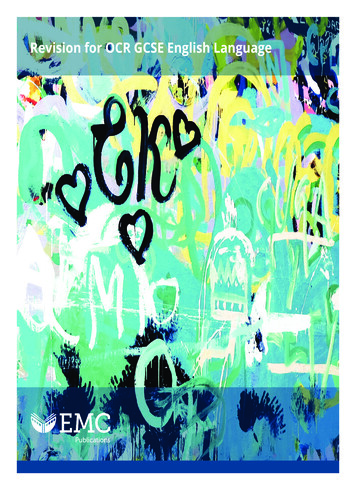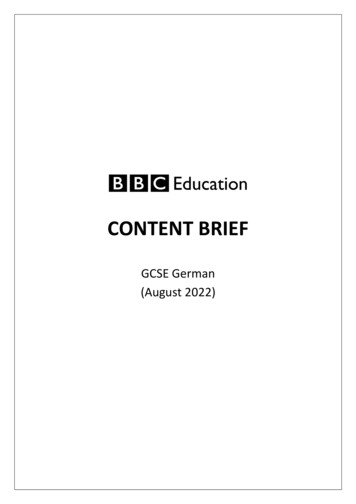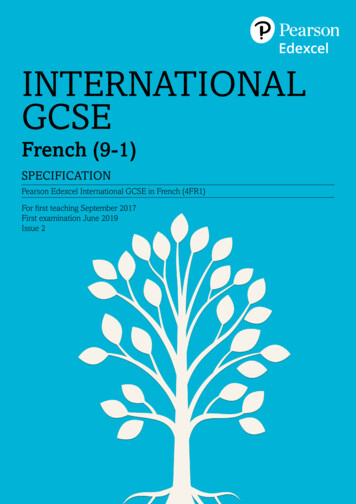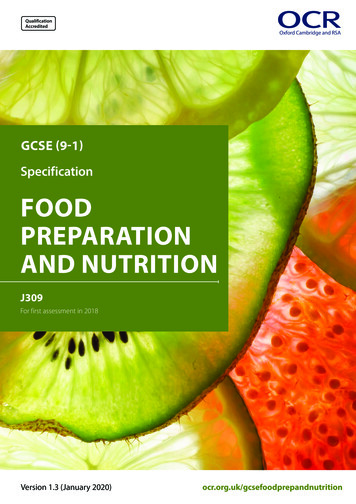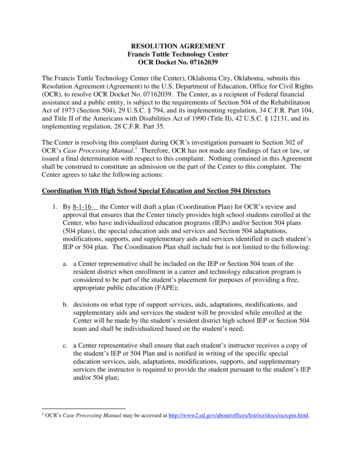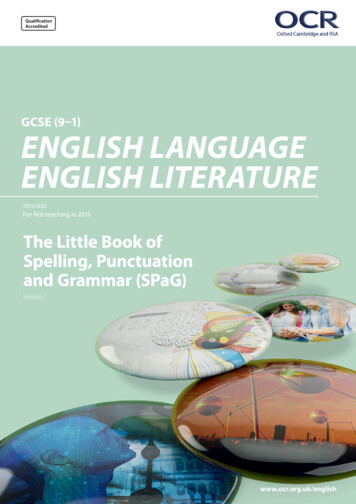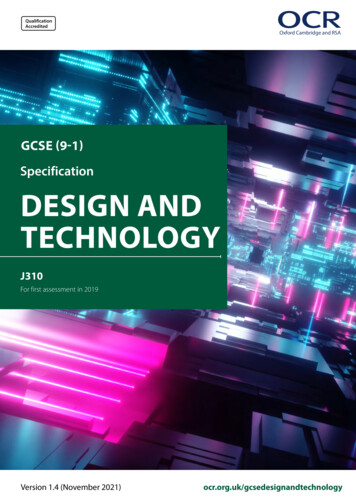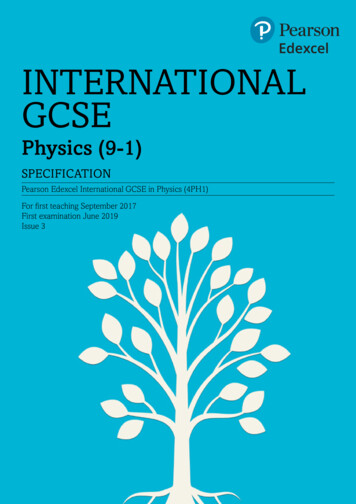
Transcription
QualificationAccreditedOxford Cambridge and RSAGCSE (9-1)SpecificationLATINJ282For first assessment in 2018Version 1.5 (April 2022)ocr.org.uk/gcselatin
DisclaimerRegistered office: The Triangle BuildingShaftesbury RoadCambridgeCB2 8EAOCR is an exempt charity.Specifications are updated over time. Whilst every effort is made to check alldocuments, there may be contradictions between published resources and thespecification, therefore please use the information on the latest specification atall times. Where changes are made to specifications these will be indicated withinthe document, there will be a new version number indicated, and a summaryof the changes. If you do notice a discrepancy between the specification and aresource please contact us at: resources.feedback@ocr.org.ukWe will inform centres about changes to specifications. We will also publishchanges on our website. The latest version of our specifications will always bethose on our website (ocr.org.uk) and these may differ from printed versions. 2022 OCR. All rights reserved.CopyrightOCR retains the copyright on all its publications, including the specifications.However, registered centres for OCR are permitted to copy material from thisspecification booklet for their own internal use.Oxford Cambridge and RSA is a Company Limited by Guarantee. Registered inEngland. Registered company number 3484466.
Contents1Support and GuidanceAssessment Preparation and Analysis ServiceiiiiiWhy choose an OCR GCSE (9–1) in Latin?111231a.1b.1c.1d.2The specification overview2a.2b.2c.2c.2c.2d.3Forms of assessmentAssessment objectives (AO)Assessment availabilityRetaking the qualificationAssessment of extended responseSynoptic assessmentCalculating qualification resultsAdmin: what you need to know4a.4b.4c.4d.4e.4f.5OCR’s GCSE (9–1) in Latin (J282)Content of GCSE (9–1) in Latin (J282)Content of Language (J282/01)Content of Literature components (J282/02, J282/03, J282/04 and J282/05)Content of Literature and Culture (J282/06)Prior knowledge, learning and progressionAssessment of GCSE (9–1) in Latin3a.3b.3c.3d.3e.3f.3g.4Why choose an OCR qualification?Why choose an OCR GCSE (9–1) in Latin?What are the key features of this specification?How do I find out more information?Pre-assessmentSpecial considerationExternal assessment arrangementsResults and certificatesPost-results servicesMalpracticeAppendices5a.5b.5c.5d.5e. OCR 2022GCSE (9–1) in Latin44567911121213141414141415151617181818Grade descriptorsOverlap with other qualificationsAccessibilityLatin Accidence and SyntaxRestricted Latin Accidence and Syntax list191919192123Summary of Updates24i
Support and GuidanceIntroducing a new specification brings challenges forimplementation and teaching, but it also opens up newopportunities. Our aim is to help you at every stage.We are working hard with teachers and other expertsto bring you a package of practical support, resourcesand training.Subject AdvisorsOCR Subject Advisors provide information and supportto centres including specification and non‑examassessment advice, updates on resource developmentsand a range of training opportunities.Our Subject Advisors work with subject communitiesthrough a range of networks to ensure the sharing ofideas and expertise supporting teachers and studentsalike. They work with developers to help produce ourspecifications and the resources needed to supportthese qualifications during their development.You can contact our Classics Subject Advisors forspecialist advice, guidance and support:01223 553998classics@ocr.org.uk@OCR ClassicsWe also work with a number of leading publishers whopublish textbooks and resources for our specifications.For more information on our publishing partners andtheir resources visit: ocr.org.uk/publishing-partnersProfessional developmentOur improved Professional Development Programmefulfils a range of needs through course selection,preparation for teaching, delivery and assessment.Whether you want to come to events, look at our newdigital training or search for training materials, you canfind what you’re looking for all in one place at the CPDHub: cpdhub.ocr.org.ukAn introduction to new specificationsWe run training events throughout the academic yearthat are designed to help prepare you for first teachingand support every stage of your delivery of the newqualifications.To receive the latest information about the trainingwe offer on GCSE and A Level, please register for emailupdates at: ocr.org.uk/updatesTeaching and learning resourcesOur resources are designed to provide you with arange of teaching activities and suggestions thatenable you to select the best activity, approach orcontext to support your teaching style and yourparticular students. The resources are a body ofknowledge that will grow throughout the lifetime ofthe specification, they include:ii Delivery Guides Transition Guides Topic Exploration Packs Lesson Elements. OCR 2022GCSE (9–1) in Latin
Assessment Preparation and Analysis ServiceAlong with subject-specific resources and tools, you’llalso have access to a selection of generic resourcesthat focus on skills development, professional guidancefor teachers and results data analysis.Subject Advisor SupportOur Subject Advisors provide you withaccess to specifications, high-qualityteaching resources and assessmentmaterials.Skills GuidesThese guides cover topics that could berelevant to a range of qualifications, forexample communication, legislation andresearch.Download the guides atocr.org.uk/skillsguidesActive ResultsOur free online results analysis servicehelps you review the performance ofindividual students or your whole cohort.For more details, please refer toocr.org.uk/activeresults OCR 2022GCSE (9–1) in Latiniii
1 Why choose an OCR GCSE (9–1) in Latin?1a. Why choose an OCR qualification?1Choose OCR and you’ve got the reassurance thatyou’re working with one of the UK’s leading examboards. Our new OCR GCSE (9–1) in Latin coursehas been developed in consultation with teachers,employers and higher education to provide learnerswith a qualification that’s relevant to them and meetstheir needs.students to become responsible for their own learning,confident in discussing ideas, innovative and engaged.We provide a range of support services designed tohelp you at every stage, from preparation through tothe delivery of our specifications. This includes: A wide range of high-quality creative resourcesincluding:oDelivery GuidesoTransition GuidesoTopic Exploration PacksoLesson Elementso and much more.We work with a range of education providers, includingschools, colleges, workplaces and other institutionsin both the public and private sectors. Over 13,000centres choose our A Levels, GCSEs and vocationalqualifications including Cambridge Nationals andCambridge Technicals. Access to Subject Advisors to support youthrough the transition and throughout thelifetime of the specifications. CPD/Training for teachers including events tointroduce the qualifications and prepare you forfirst teaching.Our Specifications Active Results – our free results analysis serviceto help you review the performance of individuallearners or whole schools.We’re part of the Cambridge Assessment Group,Europe’s largest assessment agency and a departmentof the University of Cambridge. Cambridge Assessmentplays a leading role in developing and deliveringassessments throughout the world, operating in over150 countries.We believe in developing specifications that help youbring the subject to life and inspire your students toachieve more.We’ve created teacher-friendly specifications based onextensive research and engagement with the teachingcommunity. They’re designed to be straightforwardand accessible so that you can tailor the delivery ofthe course to suit your needs. We aim to encourageAll GCSE (9–1) qualifications offered by OCR areaccredited by Ofqual, the Regulator for qualificationsoffered in England. The accreditation number for OCR’sGCSE (9–1) in Latin is QN601/8124/2.1b. Why choose an OCR GCSE (9–1) in Latin?OCR’s GCSE (9–1) in Latin has been designed to helplearners develop their understanding of the Latinlanguage and the related ancient literature, values andsociety.We have updated the traditional, popular structureof the GCSE and have added in increased optionality.This allows learners the new option to study twoprose literature components or two verse literaturecomponents, as well as the existing popular choiceof studying a prose literature component and a verseliterature component, or a literature component andthe ‘Literature and Culture’ component.1We have designed this qualification with teachersand learners in mind, having consulted extensivelyacross the United Kingdom. The subject criteria posechallenges not faced before at GCSE, for instance theneed to translate short sentences from English intoLatin or answer questions on syntax and accidence.The approach that we have taken in this specificationwill allow teachers and learners to face thesechallenges with confidence.We want to ensure that OCR’s GCSE (9–1) in Latinengages learners, develops a desire within them tocontinue learning Latin and helps develop a lifelongenthusiasm for the Classical world. OCR 2022GCSE (9–1) in Latin
Aims and learning outcomesOCR’s GCSE (9–1) in Latin will enable learners to:OCR’s GCSE (9–1) in Latin will encourage learners to: develop and deploy their knowledge ofvocabulary, morphology and syntax in order toread, understand and interpret Latin develop their knowledge and understanding ofancient literature, values and society throughthe study of original texts, adapted and abridgedas appropriatedevelop insights into the relevance of Latinand of ancient literature and civilisation to ourunderstanding of our modern world of diversecultures deploy their knowledge and understanding ofLatin to deepen their understanding of Englishand other languages select, analyse and evaluate evidence to drawinformed conclusions from the literature studiedto: relate their knowledge and understanding of theancient world to other disciplines develop research and analytical skills which willempower them to become independent learnersand enquirers, equipping them for further studyin arts, humanities and sciences. odemonstrate knowledge andunderstanding of the historical, literaryand cultural context of a textoidentify and appreciate its literary formand impact on the reader1develop and apply their critical, analytical andreflective skills to evaluate evidence from arange of sources1c. What are the key features of this specification?The key features of OCR’s GCSE (9–1) in Latin for youand your learners are: the study of ancient literature and sources whichhelps give learners an insight into the life andculture of the ancient world the freedom to create the most appropriate andengaging course which plays to the strengths ofyour learners the opportunity to develop linguistic skills whichwill help both in the study and application ofEnglish and other languagesthe encouragement to help develop and applycritical analytical skills which will help learners intheir future study it provides solid preparation for those wishingto progress to our AS and A Level Latinqualifications. OCR 2022GCSE (9–1) in Latin2
1d. How do I find out more information?1If you are already using OCR specifications you cancontact us at: www.ocr.org.ukIf you are not already a registered OCR centre thenyou can find out more information on the benefits ofbecoming one at: www.ocr.org.ukIf you are not yet an approved centre and would like tobecome one go to: www.ocr.org.ukFind out more?Ask our Subject Advisors:Email: classics@ocr.org.ukCustomer Contact Centre: 01223 553998Visit our Online Support Centre atsupport.ocr.org.ukTeacher support: www.ocr.org.uk3 OCR 2022GCSE (9–1) in Latin
2 The specification overview2a. OCR’s GCSE (9–1) in Latin (J282)Learners must complete Component 01 and then any two from Components 02, 03, 04, 05 and 06 to be awardedOCR’s GCSE (9–1) in Latin.Content OverviewAssessment OverviewLanguageCompulsory component:Learners study texts andstories in Latin to buildknowledge and understandingof Latin vocabulary, accidenceand syntax.J282/01:LanguageProse and Verse LiteratureLearners study Latin settexts and answer questionsin English on aspects ofcontent and analyse, evaluateand respond to the ancientliterature they have studied.Literature and CultureLearners study two topicson Roman Civilisation andCulture using the sourcesin the Prescribed SourcesBooklet and answer questionsin English on aspects ofcontent, culture, socialpractices and values.100 marks1 hour 30 minutesWritten paper2Thiscomponent isworth 50% oftotal GCSEOptional components –any two of the followingfive:J282/02:Prose Literature AJ282/03:Prose Literature BJ282/04:Verse Literature AJ282/05:Verse Literature BEachcomponent isworth 25% oftotal GCSEJ282/06:Literature and Culture50 marks1 hourWritten paperAll components include synoptic assessment. OCR 2022GCSE (9–1) in Latin4
2b. Content of GCSE (9–1) in Latin (J282)2The OCR GCSE (9–1) in Latin will allow learnersto develop their knowledge of Latin vocabulary,morphology and syntax so that they can read andunderstand unseen confected or adapted passages ofLatin.The vocabulary, accidence and syntax required forthe composition of Latin sentences will be taken fromrestricted lists. The accidence and syntax questions willdraw upon the full range of syntax and accidence listedin the specification.The OCR GCSE (9–1) in Latin will require learnersto know the words which are listed in the DefinedVocabulary List (DVL) as well as other specified formsof these words. The Defined Vocabulary List (DVL)will be available on the OCR website. Learners will beexpected to know and understand the application ofsyntax and accidence listed in this specification.The Literature components (02–05) will require thestudy of between 110 and 120 lines of material inLatin. These set texts will change every two years.The OCR GCSE (9–1) in Latin will develop learners’knowledge and understanding of the ancient worldthrough the study of ancient literature and ancientsources. Learners are required to study a compulsoryLanguage component together with either twoLiterature components, or one Literature componentand the Literature and Culture component.The Language component (01) requires learners totranslate a passage of Latin, answer comprehensionquestions and either answer questions on syntax andaccidence within the context of a narrative passage ortranslate short English sentences into Latin.5The Literature and Culture component (06) willrequire the study of two different topics throughthe exploration of the prescribed sources listed inthe Prescribed Sources Booklet, which is available onthe OCR website, and other sources which cover thesame topic areas. The material for the Literature andCulture component will remain for the lifetime of thespecification.The set texts and topics will be reviewed after threeyears and may be subject to change. Each set textand topic will remain on the list for the lifetime of thequalification, unless the review process identifies anecessary change. If a text is to be removed from thelist and replaced with another text, centres will benotified a year in advance. OCR 2022GCSE (9–1) in Latin
2c. Content of Language (J282/01)In the course of this component, learners will developtheir knowledge of Latin vocabulary and linguisticstructures through reading and studying texts andstories in Latin. They will then demonstrate theirlinguistic competence through the translation andcomprehension of unseen Latin passages.Learners will also be able to demonstrate theirlinguistic ability by either recognising, analysing andexplaining accidence and syntax within the context ofa narrative passage or by translating short sentencesfrom English into Latin.Learners should be able to:Learners will be required to: recognise, analyse and/or deploy, as appropriate,the accidence and syntax listed in Appendix 5dand 5e translate an unseen passage of confected oradapted Latin demonstrate knowledge of the vocabulary in theDefined Vocabulary List (DVL) understand and respond to unseen passages ofLatin accurately translate unseen material into English understand the derivation of English words fromLatin demonstrate an understanding of unseen Latin,confected or adapted material, including anunderstanding of individual words, phrases orsentences explain the derivation of English words from Latinas evidence of the continuing influence of theclassical world on later times.2and either translate short sentences from English into Latindrawn from the Restricted Vocabulary List (RVL)and the Restricted Syntax and Accidence listed inAppendix 5eor recognise, analyse and explain syntax andaccidence, as defined below, using the Syntaxand Accidence listed in Appendix 5d recognise: identify examples of a grammaticalform analyse: identify the grammatical form of aword explain: account for the use of a grammaticalform in a sentence. OCR 2022GCSE (9–1) in Latin6
2c. Content of Literature components (J282/02, J282/03, J282/04 andJ282/05)2These components are designed to develop learners’knowledge and understanding of ancient literaturethrough studying the set text listed on the oppositepage. These components assess learners’ ability toanalyse, evaluate and respond to the ancient literaturethey have studied.Learners should be able to:Learners will be required to: demonstrate knowledge and understanding ofthe set text, including identification of aspects ofcontent, culture, social practices and values, asappropriate to the text studied understand and respond to aspects of contentand the context of the set text(s) identify, explain and respond to the use ofcommon literary effects appropriate to the settext studied and the impact on the readertranslate a short passage of the set text intoEnglish analyse aspects of content, providing a personalresponse to the literature identify, explain and respond to aspects ofliterary style, as appropriate to the text studied,such as: recognise and analyse aspects of literary style,characterisation, strength of argument andliterary meaning as appropriate to the set textstudied, and the impact these might have on thereader draw together their knowledge andunderstanding of the text studied, anddemonstrate this through a written response. choice of words and word order sounds length of clauses common literary devices, such as simile,metaphor, alliteration, assonance7Learners will study the set text listed on the oppositepage for the relevant year. Each set text or group oftexts will be between 110 and 120 lines in length, andwill be examined for a maximum of two years. demonstrate an understanding of the cultural,historical and literary context in which theliterature was composed select, analyse and evaluate evidence to drawinformed conclusions and make a reasoned,evidence-based response to the material studied. OCR 2022GCSE (9–1) in Latin
OCR 2022GCSE (9–1) in LatinSummary of the Latin set texts for examination between 2020 and 2026Set text forexamination in:2020, 2021 and20222023 and 2024J282/02J282/03J282/04J282/05Prose Literature AProse Literature BVerse Literature AVerse Literature BOxford Latin AnthologyCambridge Latin AnthologyOxford Latin AnthologyOxford Classical TextLand and seaGermanicus et PisoPassions and PoisonsA governor travels to his provinceThe army on land and sea, sectiona, A difficult landingPiso in Syria, The death ofGermanicus, Mourning, RevengeA snake’s poison stirs passionVirgil, Aeneid, 2.506–558,705–740, 768–794Hannibal crosses the AlpsRegulus, lines 1–19 (assem .detestatur)Catullus struggles with loveOxford Latin AnthologyCambridge Latin AnthologyCambridge Latin AnthologyOxford Classical TextConflict and conquestsagae ThessalaeEcho et NarcissusBravery and strategy in battlelines 1–96, (iuvenis . obtexi)lines 1–82, (aspicit . albis)Inspiration for the fight, lines1–37 (Boudicca . finivit)personae non grataeamorVirgil, Aeneid, 6.295–316,384–416, 679–712, 752–759,788–800PythiusHow many kisses?Conflicting emotionsLove will not let the poet sleepOxford Latin AnthologyCambridge Latin AnthologyCambridge Latin AnthologyOxford Classical TextVice and VirtueMessalinaBaucis et PhilemonVirgil, Aeneid, 1.12–123The corruption and cruelty ofVerres and CleomenesAdultery, Messalina isdenounced, the death ofMessalinalines 1–76Marital Conflict2025 and 2026The bravery of Mucius Scaevolaand Cloeliapersonae non grataeavunculus meusA day in the life of Pliny the ElderMedea’s impassioned plea toJasonotiumPoetry and friendshipCatullus invites a friend to dinner82
2c. Content of Literature and Culture (J282/06)2This component is designed to develop learners’knowledge and understanding of Roman civilisationand culture through the study of ancient literature andother ancient source material.Learners should also study additional ancient sourcescovering similar content to help illustrate the topicsthey are studying and provide opportunities forcomparison.Learners should study the prescribed ancient sourcematerial in the ‘Prescribed Sources Booklet’ for both ofthe topic areas set in any given year.The topic areas and the prescribed sources booklet willremain the same for the whole life of the specification.Learners should be able to:Learners will be required to: use a range of ancient sources including literary,inscriptional and archaeological identify aspects of content, culture, socialpractices and values, as appropriate to thesources studiedrecall knowledge from the prescribed sourcesand select knowledge from the unseen sourcesprovided for the assessment use their knowledge of Entertainment, TheRomans in Britain and Myths and Beliefs, andstudy of evidence to widen their understandingof Roman societydemonstrate understanding of the prescribedsources and the unseen sources provided for theassessment understand and respond to the sources,evaluating them as evidence for the ancientworld and analysing their specific features evaluate the usefulness of primary sourcesas evidence through comprehension andcomparison, identifying gaps in the evidence,distortion for literary effect or bias compare and contrast ideas, values and socialpractices from the ancient and modern worlds draw together their knowledge andunderstanding of the material studied anddemonstrate this through a written response. select, analyse and evaluate evidence to drawan informed conclusion and make a reasoned,evidence-based response to the material studied.The set topics for examination in 2020, 2021 and 2022 for this component will be: Myths and Beliefs The Romans in BritainThe set topics for examination in 2023 and 2024 for this component will be: The Romans in Britain EntertainmentThe set topics for examination in 2025 and 2026 for this component will be: Entertainment Myths and Beliefs9 OCR 2022GCSE (9–1) in Latin
The Romans in BritainThe following should be studied with reference to Roman Britain Roman ArmyCamp layout, life in camp including training. Roman Roads2Construction, principal routes across Britain. Roman VillasVilla buildings, the villa estate. Roman BathLayout of the bath complex, links with religion.Entertainment The AmphitheatreIn Pompeii, the Colosseum, types of Gladiators. The Theatre at PompeiiScenery and props, actors, plays. The Circus Maximus and Chariot RacingThe structure, charioteers and races. Dinner partiesThe triclinium, entertainment at dinner.Myths and Beliefs Roman GodsJupiter, Juno, Mars, Venus, Neptune, Minerva, Apollo, Diana, Vulcan, Vesta, Pluto, Mercury and their roles. State ReligionTemple of Jupiter in Pompeii, sacrifices. Beliefs in the After-LifeTombs in Pompeii, beliefs about life after death. Aeneas, Romulus and RemusThe exile from Troy, visit to the underworld, Romulus and Remus found Rome. OCR 2022GCSE (9–1) in Latin10
2d. Prior knowledge, learning and progressionLearners who are beginning a GCSE (9–1) course arelikely to have followed a Key Stage 3 programme ofstudy. No prior knowledge of this subject is requiredbut may be beneficial.2GCSEs are qualifications that enable learners toprogress to further qualifications either Vocational orGeneral.11This qualification provides the ideal foundation forlearners to progress to OCR’s AS Level in Latin and ALevel in Latin.Find out more at www.ocr.org.uk OCR 2022GCSE (9–1) in Latin
3 Assessment of GCSE (9–1) in Latin3a. Forms of assessmentOCR’s GCSE (9–1) in Latin consists of three components that are externally assessed. Learners must sit J282/01and then any two from J282/02, J282/03, J282/04, J282/05 and J282/06.J282/01 LanguageThis is a compulsory component. It is worth100 marks, representing 50% of the total marks for theGCSE (9–1).Latin Language is an externally assessed writtenexamination testing AO1.The examination lasts 1 hour 30 minutes and is formedof two sections.Section A consists of 30 marks. In Section A, theunseen passage will recount a story drawn frommythology or Roman domestic life.20 marks are available for answering comprehensionquestions in English, including questions about thederivation of English words from Latin.10 marks (10% of AO1 overall) are available forlearners to choose between either answeringquestions on accidence and syntax or translating threebasic English sentences into Latin.The syntax and accidence questions draw upon the fullsyntax and accidence listed in Appendix 5d.The restricted vocabulary, accidence and syntax listapplies only to the translation into Latin.Section B consists of 70 marks. In Section B, theunseen passages will recount a story or stories drawnfrom history.20 marks will be available for answeringcomprehension questions in English.50 marks will be available for translating a passage ofunseen Latin of at least 90 words into English.J282/02, J282/03, J282/04, J282/05 LiteratureThese are optional components. Each component isworth 50 marks, representing 25% of the total marksfor the GCSE (9–1).These components are externally assessed writtenexaminations testing AO2 and AO3.Each examination lasts 1 hour.Learners will be asked to translate a short passageof the set text from Latin into English and answercomprehension questions. They will also be requiredto answer analysis questions which will be marked ona point by point basis and an 8-mark analysis questionwhich is marked using a level of response grid.Learners will also be required to write an extendedresponse, which draws upon material from the set text.Each component tests understanding and appreciationof a prescribed set text which is between 110 and 120lines in length. OCR 2022GCSE (9–1) in Latin123
J282/06 Literature and CultureThis is an optional component. It is worth 50 marks,representing 25% of the total marks for the GCSE(9–1).Literature and Culture is an externally assessed writtenexamination testing AO2 and AO3.The examination lasts 1 hour.3Questions will require learners to demonstrateknowledge and understanding of the materials in the‘Prescribed Sources Booklet’ and their own study aswell use the unseen sources provided in the insertbooklet for the assessment.Questions will also require learners to analyse thesources provided in the assessment, provide a personalresponse to the material studied and answer extendedresponse questions.3b. Assessment objectives (AO)There are three Assessment Objectives in OCR GCSE(9–1) in Latin. These are detailed in the table below.Learners are expected to demonstrate their ability to:Assessment ObjectiveAO1Demonstrate knowledge and understanding of the language.AO2Demonstrate knowledge and understanding of literature and/or other ancient sources.AO3Analyse, evaluate and respond to literature and/or other ancient sources.AO weightings in OCR GCSE (9–1) LatinThe relationship between the Assessment Objectivesand the components are shown in the following table:Component% of overall GCSE (9–1) in Latin (J282)AO1AO2AO3Language50%0%0%Prose Literature A0%12.5%12.5%Prose Literature B0%12.5%12.5%Verse Literature A0%12.5%12.5%Verse Literature B0%12.5%12.5%Literature and Culture0%12.5%12.5%Total50%25%25%13 OCR 2022GCSE (9–1) in Latin
3c. Assessment availabilityThere will be one examination series available eachyear in May / June to all learners.This specification will be certificated from the June2018 examination series onwards.All examined components must be taken in the sameexamination series at the end of the course.3d. Retaking the qualificationLearners can re-take the qualification as many timesas they wish. Learners must retake Component 01 andtwo components from Component 02 to 06, in thesame examination series.33e. Assessment of extended responseThe assessment materials for this qualification providelearners with the opportunity to demonstrate theirability to construct and develop a sustained and3f.coherent line of reasoning and marks for extendedresponses are integrated into the marking criteria.Synoptic assessmentSynoptic assessment targets learners’ understandingof the connections between different elements of thesubject. It involves the explicit drawing together ofknowledge, skills and understanding within differentparts of the GCSE course.Synoptic assessment encourages the understandingof Latin as a discipline and requires learners todemonstrate understanding of the links betweenlanguage and literature in their classical contexts.3g. Calculating qualification resultsA learner’s overall qualification grade GCSE (9–1) inLatin will be calculated by adding together their marksfrom the three components taken to give their totalweighted mark. OCR 2022GCSE (9–1) in LatinThis mark will then be compared to the qualificationlevel grade boundaries for the entry option takenby the learner and for the relevant exam series todetermine the learner’s overall qualification grade.14
4 Admin: what you need to kno
Latin or answer questions on syntax and accidence. The approach that we have taken in this specification will allow teachers and learners to face these challenges with confidence. We want to ensure that OCR's GCSE (9-1) in Latin engages learners, develops a desire within them to continue learning Latin and helps develop a lifelong
